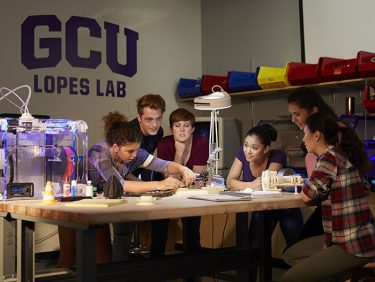Editor's note: This story is reprinted from the February issue of GCU Magazine, an inside look at the unprecedented growth of the University in the last decade. To read the digital version of the magazine, click here.
By Mike Kilen
GCU Magazine
Ten years ago, this small college in west Phoenix was known to produce teachers, preachers and nurses among its approximately 1,000 undergraduate ground students in a handful of old buildings.
About that time, Dr. Hank Radda pulled up to Grand Canyon University early for a job interview. The Arena was nothing but iron beams and the parking lot was broken asphalt when he got out of his car and was spotted by GCU President Brian Mueller.
Mueller asked him if he had a few minutes to walk around before his interview. Although Mueller “painted a picture,” as Radda recalls, of a thriving, Christian university – in line with the country’s finest private institutions but affordable to all socioeconomic classes -- Radda was looking into a lot of empty space amid a rugged neighborhood.

“Seriously? With these World War II buildings?” he thought.
But by the end of the 20 minutes, he was convinced to take a job.
Radda, today the University’s Provost and academic leader, joined Mueller and the rest of a small, eager team that accepted Mueller’s challenges to develop academic programs for the jobs of the future – in computer science, engineering, math and business.
Over 10 years, GCU grew from seven colleges to nine and more than doubled its academic programs from 94 to 238.
“Nothing is slow here,” said Dr. Mark Wooden, Dean of the College of Science, Engineering and Technology. “We go after things full blast and make them happen. That is a unique characteristic of GCU. We make things happen for the students.”
Developing a computer science program in 2014 was part of the vision, followed quickly by the engineering programs in 2015, focused first on electrical, mechanical and biomedical. The new Engineering Building opened in 2016.
Today, the number of engineering students (more than 800) is similar to the entire ground student population when Wooden arrived in 2004. They study a curriculum that is designed with assistance from industry professionals — GCU has 18 advisory boards, encompassing more than 400 members who share what they need from graduates.
When they said there was a need for cybersecurity professionals, GCU launched the Cyber Center of Excellence in 2017. When employers wanted people who can work on an interdisciplinary team, understand how projects unfold and follow design principles, Wooden said, “we built that into our curriculum.”
“It sets up our students to be more competitive when they get out,” he said. “They not only have engineer skills, but they have those softer skills to be able to hit the ground running and work on a team.”
Mueller said: “We are very blue collar, nuts and bolts, about building academic credibility.”
That approach led to other expansions. An Honors Institute with 59 students grew in two years to about 700 and in 2015 became the Honors College, which had approximately 2,200 students as of fall 2019.
“We started to attract a really high caliber of students here at GCU,” said Breanna Naegeli, Associate Dean of the Honors College.
The grade point average of incoming students has risen from 2.7 to 3.5, and the incoming Honors College students average 4.1 as of fall 2019.
She credits the sense of an inclusive community that, despite its growth, hasn’t lost its personal touch.
“It’s almost like the bigger we get, the better we get at serving students,” Naegeli said. “We are service focused. It’s to support students. It’s not to collect a paycheck or teach another course or put this on a resume. They are here because of the community we created.”
Students come first at GCU, but faculty also have been busy building a body of expertise. For example, the Center for Innovation in Research and Teaching (CIRT) has grown, since its 2010 launch, from no peer-reviewed academic journals to publishing five, said Jean Mandernach, CIRT’s Executive Director, noting GCU faculty’s more than 10,000 academic publications and presentations since 2010.
The growth of the Colangelo College of Business (CCOB) has been equally dramatic. From 400 students in 2010, it has become one of the nation’s largest business schools, with nearly 4,500 students, thanks to the influence of its namesake, Phoenix business icon Jerry Colangelo. The sports business school was launched under his name in 2012, followed by the hospitality program and Canyon Angels investment group in 2015 and the Canyon Ventures entrepreneurship innovation center in 2019.
“When you have an idea, as long as you can articulate how it will help students and improve their learning experience, we have full support from University leadership,” said Dr. Randy Gibb, Dean of the CCOB, which moved into a new building for the fall 2018 semester. “Then we do it. Bureaucracy isn’t thrown at you. The entrepreneurial spirit of GCU is lived out in everything that we do.”
Wooden said there has been a special aura over GCU since he arrived, and he has felt “no arrogance or elitism and that everyone was kind to each other and lifted each other up.”
“I really feel we still have that. The students are more than 22,000, but we still have a community. You’ve got to love community. You’ve got to be a team player. That’s who we hire. We wouldn’t be successful if we didn’t. Nobody is more important than another person around here.”
You’ve also got to love change, he said. The past decade at GCU, there’s been plenty of that.
Grand Canyon University senior writer Mike Kilen can be reached at [email protected] or at 602-639-6764.
****
Related content:
GCU Magazine: Community shines through in GCU's dazzling decade
GCU Magazine: Here's what makes GCU campus worth the walk















